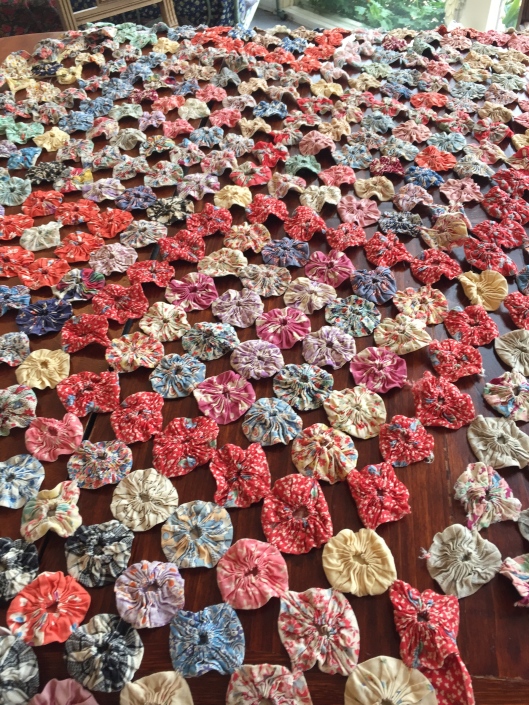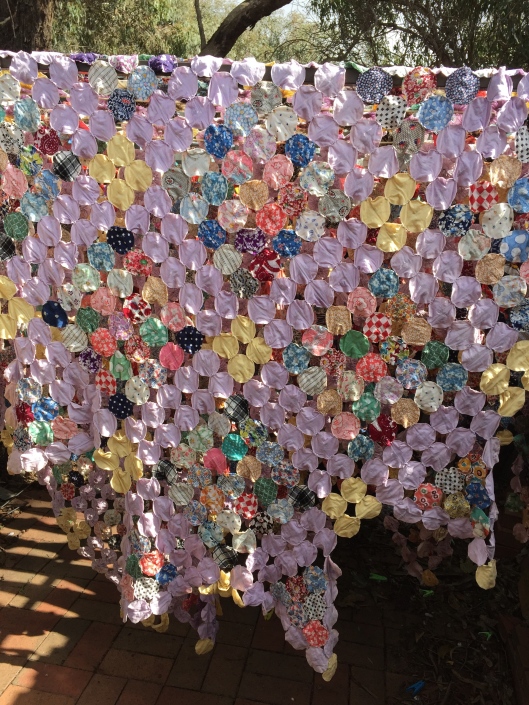
It is uncertain of when and where the technique for making yo-yo quilts originated. The earliest known examples date to the 1920s but the technique and pattern became prominent in the next decade. By the 1930s patterns were appearing in the women’s pages of weekly publications. In Merikay Waldvogel’s book ‘Soft Covers for Hard Times’ it is recorded that kits containing materials and instructions were available for making yo-yo projects.
Due to its simplicity and minimal requirements, yo-yo quilts were very popular during the depression era. All that is needed to make a yo-yo quilt is a large supply of scraps, a circle template, a needle and thread. They are a very portable project, that can be put down and picked up again for a few moments of stitching. It is easy to imagine the busy women of this era making a couple of yo-yos when they could spare a few moments

A bundle of yo-yo quilts
.
The two yo-yo quilts in my collection were purchased from The Donnellys.
Eileen and Bernie shared the story of how and where they found them. The quilts were bought from an antique shop in Winchester, New Hampshire USA on 7th October 1994. They were lying on the very dirty floor of the shop.
Of the two quilts one is in good condition and the second one needs some repair work.

area needing repair
The first quilt is constructed with 25 yo-yos stitched 5 x 5 to make a block. The blocks are joined with 2 rows of mauve yo-yos to create a lattice effect. Four lemon yo-yos are placed as cornerstones. The maker then created lovely bunting type triangles to give her quilt a very decorative finish.

Lay-out arrangement

Decorative finish
The second quilt is a random design but is brighter than the first quilt. Both quilts contain a great assortment of fabrics including feed sacks, dress fabrics, shirtings, ginghams, stripes and juvenile prints. The first quilt was probably the best quilt and the second was the everyday quilt receiving much more wear.

Brighter colours and random placement.
I soaked the quilts for 36 hours in Retro Clean.

Soaking the quilts
After soaking I transferred them to the washing machine. Yo-yo quilts are very heavy and once wet even more so. They had to be machine washed in two separate loads. Once washed and dry I assessed the repair work. The first quilt only needed a couple of yo-yos restitched and two needed replacing. The second quilt is in the repair pile awaiting restoration. Both quilts are a wonderful time capsule of the fabrics from the 1930s and probably include fabrics from earlier decades.

Reverse side of quilt.

Detail of fabrics
I hope you enjoyed the stories of the yo-yo quilts. Thank you for stopping by,
Hope your stitching is going well, regards Janette – The Plain Needlewoman.

Thank you Janette for another informative article and lovely photography
LikeLike
Hi Joy, Glad you liked the post, the ladies up at Sunbury were very interested in the yo-yo quilt. A lot of people have never seen a finished quilt made with yo-yos. Thanks for your comment, Janette
LikeLike
Love these two yo yo quilts, what a lot of work these ladies of the past put into them. As for a fabric study, amazing to see…beautiful, Janette…
LikeLike
Hi Lorraine,
Yes these ladies achieved a lot! glad you liked the post and the fabrics. Janette
LikeLike
This is the first time I have seen yo – yo quilts that had a pattern. Lovely. Thanks for sharing this informative article.
LikeLike
Glad you liked the post!
LikeLike
Interesting, I’ve never paid much attention to yo yo quilts, about time I did ,for these two quilts are lovely!
LikeLike
Hi Deb, glad you liked the quilts, they are nice and great for fabric study, Janette
LikeLike
Thank you Janette for your suitcase display, of your antique quilts to our Sunbury Group. We thoughourly enjoyed every quilt. The YoYo quilts certainly had a lot of work put into them. A great way to utilise scraps.
cheers
LikeLike
Thank you Lyn, Glad you enjoyed seeing the quilts. I enjoyed showing them to your group. I will look forward to visiting your exhibition next year. Janette
LikeLike
I’ve been working on yo-yos for about two years–I need to count and see how many I have! Seeing these two vintage quilts, and how lovely they are, will give me renewed enthusiasm for my project!
LikeLike
Hi Kerry,
Glad you feel inspired to continue on with your yo-yo quilt after reading the blog. It really is amazing how some of the quilters of the past achieved so much. Good luck with your yo-yo making, kind regards
Janette
LikeLike
Your post and information about Yo-Yo Quilts/Coverlets has heightened my appreciation for a special piece that has come through my husband’s family. In fact, some of the fabrics in ours are extremely similar, if not identical to several that I see in the last photo in this post (even more intriguing!). Ours originated in Eastern Pennsylvania, and I wonder if certain dress fabrics were popular at a particular time in the Northeastern U.S.? Thanks for your work! — Elizabeth
LikeLike
Hi Elizabeth, Glad you enjoyed the post on Yo-Yo quilts. It is lovely to have a quilt that has been handed down through your family. I am sure fabric designs were popular and ‘in fashion’ at certain times, just like today. I think the quilters also shared their fabrics and a lot of scraps would have been passed from one quilter to another. Thanks for sharing your story with me, Happy quilting.. Janette
LikeLike
Hi Elizabeth, Sorry for this rather late reply. I missed seeing your comments. I’m sure dress fabrics were popular in the 30s and other periods just as they are today. It’s wonderful you have a family heirloom. Regards Janette
LikeLike
Pingback: Yo-Yo Quilts | Perigrines Eyrie